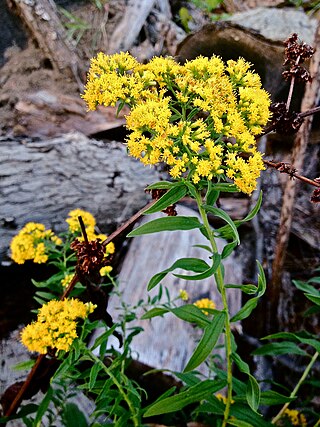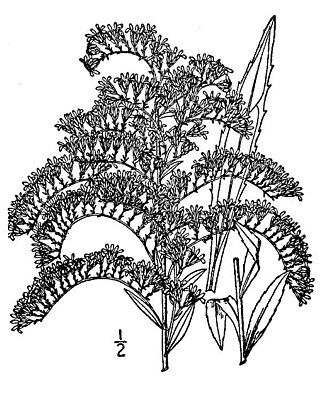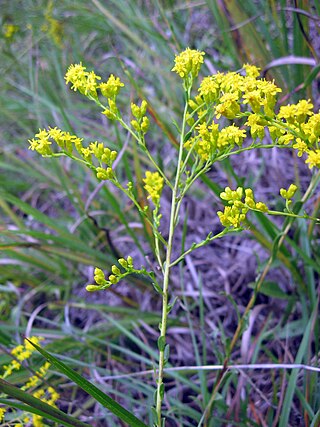
Euthamia is a genus of flowering plants in the family Asteraceae. They are known as goldentops and grass-leaved goldenrods.

Solidago canadensis, known as Canada goldenrod or Canadian goldenrod, is an herbaceous perennial plant of the family Asteraceae. It is native to northeastern and north-central North America and often forms colonies of upright growing plants, with many small yellow flowers in a branching inflorescence held above the foliage. It is an invasive plant in other parts of the continent and several areas worldwide, including Europe and Asia. It is grown as an ornamental in flower gardens.

Solidago shortii, commonly known as Short's goldenrod, is a species of goldenrod in the family Asteraceae. The only known populations of Short's goldenrod occur around the Blue Licks Battlefield State Park area of Kentucky and Harrison-Crawford State Forest in Indiana. It was listed on the Federal Register of Endangered Species on September 5, 1985, and was given a global rank of G1 on February 29, 2000.

Solidago nemoralis is a species of flowering plant in the family Asteraceae. It is native to North America, where it is widely found in Canada and the United States. Its common names include gray goldenrod, gray-stem goldenrod, old-field goldenrod, field goldenrod, prairie goldenrod, dwarf goldenrod, and dyersweed goldenrod.

Solidago gigantea is a North American plant species in the family Asteraceae. Its common names include tall goldenrod and giant goldenrod, among others.

Solidago californica is a species of goldenrod known by the common name California goldenrod.
Solidago guiradonis is an uncommon species of goldenrod known by the common name Guirado goldenrod. It is native to the Central California Coast Ranges of central California, in southern San Benito and western Fresno Counties.

Solidago multiradiata is a species of goldenrod known by the common names Rocky Mountain goldenrod, northern goldenrod, and alpine goldenrod. It is native to North America, where it can be found throughout the northern regions, including Alaska and most of Canada (all 3 territories plus all provinces except Prince Edward Island, including territory north of the Arctic Circle. Its distribution extends through the western United States as far south as Arizona, New Mexico, and California. It is known mostly from the subalpine and alpine climates of high mountain ranges. Its habitat includes tundra and mountain meadows.

Solidago spectabilis is a species of goldenrod known by the common names Nevada goldenrod, basin goldenrod, and showy goldenrod. It is native to the western United States in the Great Basin and surrounding areas. It is found in California, Arizona, Nevada, Oregon, and Utah. There are historical records saying it once grew in southwestern Idaho, but is now extirpated there. This variety has also been seen in the western Montana county of Sanders.

Solidago spithamaea is a species of flowering plant in the family Asteraceae known by the common name Blue Ridge goldenrod. It is native to a very small region around the border between North Carolina and Tennessee in the United States. Its three remaining populations are threatened by the loss and degradation of its habitat. It is a federally listed threatened species of the United States.

Solidago albopilosa is a rare species of flowering plant in the family Asteraceae known by the common name whitehair goldenrod.

Solidago houghtonii is a rare North American species of flowering plant in the family Asteraceae known as Houghton's goldenrod. It is native to southern Ontario, Canada and the northern United States. It is threatened by the loss and degradation of its habitat. It is a federally listed threatened species of the United States and it is designated a species of special concern by Canada's Committee on the Status of Endangered Wildlife in Canada.

Liatris punctata is a species of flowering plant in the family Asteraceae known by the common names dotted gayfeather, dotted blazingstar, and narrow-leaved blazingstar. It is native to North America, where it occurs throughout the plains of central Canada, the central United States, and northern Mexico.

Solidago ouachitensis is a North American species of flowering plants in the family Asteraceae known by the common name Ouachita Mountain goldenrod. It has a very limited range, found only in the Ouachita Mountains along the border between Arkansas and Oklahoma in the United States.
Solidago verna is a species of flowering plant in the aster family known by the common names springflowering goldenrod and spring goldenrod. It is native to North Carolina and South Carolina in the United States.

Solidago villosicarpa is a species of flowering plant in the family Asteraceae known by the common names hairy-seed goldenrod, coastal goldenrod, glandular wand goldenrod, and shaggy-fruit goldenrod. It is endemic to North Carolina in the United States, where there are only four known populations.

Solidago gattingeri, common name Gattinger's goldenrod, is a species of plant that is a goldenrod. It is native only to the Ozark Mountains of Arkansas and Missouri and to the Nashville Basin of Tennessee. Its preferred habitat is cedar glades, cedar barrens, and limestone outcrops. It is adapted to dry habitats.

Solidago riddellii, known as Riddell's goldenrod, is a North American plant species in the genus Solidago of the family Asteraceae. It grows primarily in the Great Lakes and eastern Great Plains of Canada and the United States. It is sometimes considered part of the genus Oligoneuron, but as a Solidago, included in the section Solidago sect. Ptarmicoidei, the flat-topped goldenrods.

Solidago rigida, known by the common names stiff goldenrod and stiff-leaved goldenrod, is a North American plant species in the family Asteraceae. It has a widespread distribution in Canada and the United States, where it is found primarily east of the Rocky Mountains. It is typically found in open, dry areas associated with calcareous or sandy soil. Habitats include prairies, savannas, and glades.

Solidago radula, the western rough goldenrod, is a North American plant species in the family Asteraceae. It is found primarily in the southern Great Plains and the Mississippi Valley of the United States, with isolated populations farther east in Kentucky, Georgia, and the Carolinas.



















